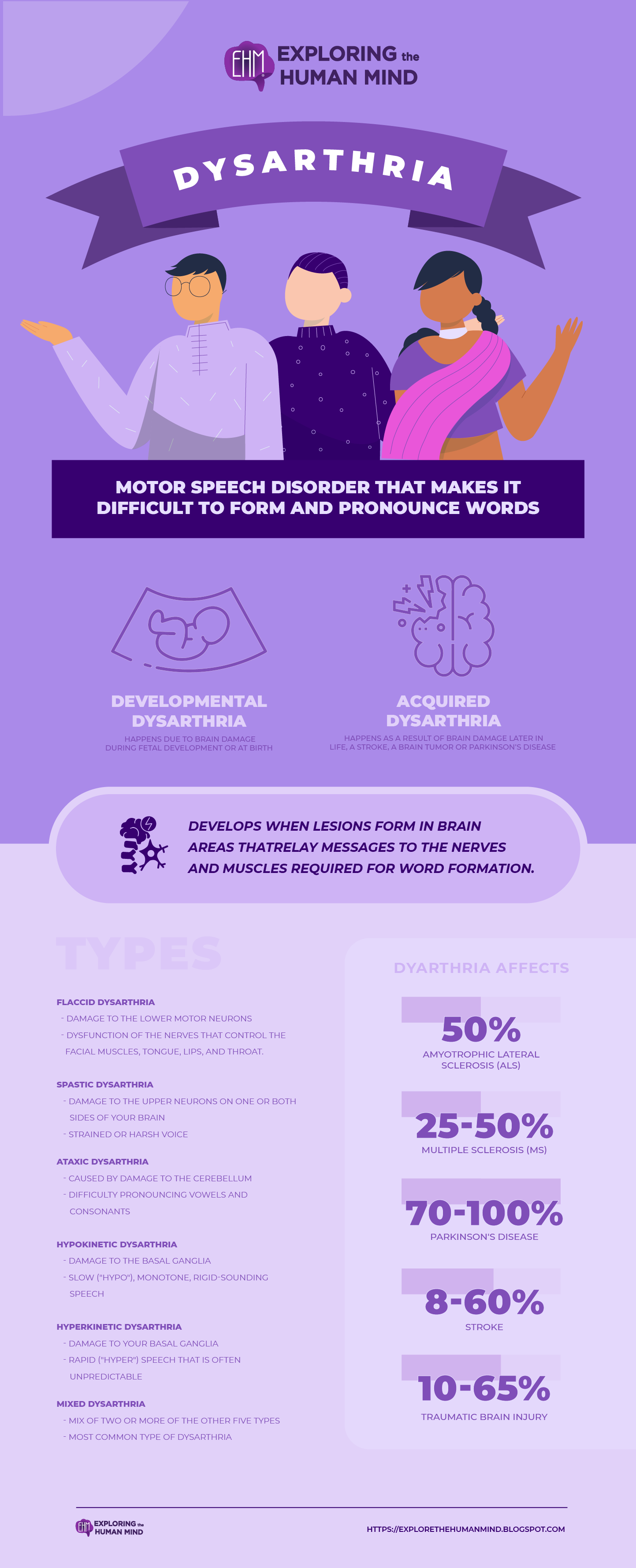Dysarthria
Dysarthria can be developmental or acquired:
- Developmental dysarthria happens due to brain damage during fetal development or at birth. For example, cerebral palsy can cause dysarthria. Children tend to have developmental dysarthria.
- Acquired dysarthria happens as a result of brain damage later in life. For example, a stroke, a brain tumor or Parkinson’s disease can lead to dysarthria. Adults tend to have acquired dysarthria.
People with dysarthria understand language. They know what they want to say and how to say it. It’s just that muscle weakness makes speaking difficult.
Causes
Dysarthria develops when lesions form in brain areas that relay messages to the nerves and muscles required for word formation.
One type of dysarthria, known as ataxic dysarthria, causes scanning speech when lesions form in the cerebellum, the part of the brain responsible for movement and coordination. This is why your speech may sound choppy or robotic. Cerebellar lesions can also cause a speech pattern that sounds like short bursts of words separated by pauses. This is why it is also known as staccato speech or explosive speech.
Types
Dyarthria is classified into six types. They are classified according to the part of your nervous system that is affected. Damage to various parts of your nervous system, including your brain and spinal cord (central nervous system) and the network of nerves that carry signals throughout your body (peripheral nervous system), can cause dysarthria.
- Flaccid dysarthria.Damage to the lower motor neurons causes flaccid dysarthria. Your peripheral nervous system includes your lower motor neurons. Your speech may sound breathy and nasal if you have flaccid dysarthria.
- Spastic dysarthria. Damage to the upper neurons on one or both sides of your brain causes spastic dysarthria. Upper neurons are a component of your central nervous system. Your voice may be strained or harsh.
- Ataxic dysarthria. Caused by damage to the cerebellum, a part of the brain. Your cerebellum aids in the coordination of muscle movement. You may have difficulty pronouncing vowels and consonants, as well as emphasising the correct parts of a word when speaking.
- Hypokinetic dysarthria.Caused by damage to the basal ganglia in your brain. The basal ganglia is a structure within your brain that aids in muscle movement. Slow ("hypo"), monotone, rigid-sounding speech is associated with hypokinetic dysarthria.
- Hyperkinetic dysarthria.Damage to your basal ganglia can also cause hyperkinetic dysarthria. It is associated with rapid ("hyper") speech that is often unpredictable.
- Mixed dysarthria. Includes a mix of two or more of the other five types. It’s the most common type of dysarthria.
Dysarthria is more common in people suffering from certain neurological disorders, such as:
- Amyotrophic lateral sclerosis (ALS): Dyarthria affects up to 30% of people with ALS (Lou Gehrig's disease)
- Multiple sclerosis (MS): Dyarthria affects 25% to 50% of people with MS at some point
- Parkinson's disease: Dysarthria affects 70% to 100% of Parkinson's disease patients
- Stroke: Dyarthria affects 8% to 60% of stroke patients
- Traumatic brain injury: Dyarthria affects 10% to 65% of people who have suffered a traumatic brain injury
Symptoms
Dysarthria symptoms include:
- Slurred speech or mumbling when speaking are symptoms of dysarthria
- Speaking either too quickly or too slowly
- Speaking at a lower or higher volume than intended
- Hoarse, harsh, strained, breathy, nasal, robotic, or monotone voice
- Instead of complete sentences, speak in short, choppy bursts with several pauses
Treatment
Suggestions for treatment include:
- Speech therapy
- Sometimes the use of a communication device
Some dysarthria sufferers find relief through speech therapy. Exercises for the muscles, repetition of words or sentences, and breathing exercises may be used in speech therapy. Therapists may advise using a letter or picture board, a computer-based device with a keyboard and message display, or both if dysarthria is severe.

vectors by Freepick; graphic design by Vadot
Reference:
Cerebellar Dysarthria (Speech) | Digital Magazine of the SSRA. Living with Superficial Siderosis. (2017, December 15). https://livingwithss.com/glossary/cerebellar-dysarthria/
Clinic, C. (2023). Dysarthria (Slurred Speech): Symptoms, Causes & Treatment - Cleveland Clinic. Cleveland Clinic. https://my.clevelandclinic.org/health/diseases/17653-dysarthria






Comments
Post a Comment